





Collapsible content
This is a prediction game for three or more players ages 10 and up, that tests your social awareness. Given a category, try to come up with the top three 3 answers that will match what other people write down.
The game comes with a box of 200 double-sided category cards, 55 wooden penalty blocks, a 30 second timer and pencil & paper for each player.
Eye to Eye encourages players to think beyond their own borders. How will other people answer this question? It lets a group of people learn about each other, and validate what they already know.
Setup the penalty blocks in a pyramid in the center of the table. Everyone can help create this structure to make it go quickly. Give each player a pencil and paper, as well as a veto chip. This veto power allows each player a chance to eliminate one category they would really prefer to skip. The starting player is the person at the table who has the most unique eyes.
Draw a category card from the box and read it aloud to the group, then start the sand timer. Each player must quickly write down exactly three answers they think best match the category.
Here's an example: The category is 'Types of Candy Bars'. After time runs out, I read my answers: Snickers, which everyone at the table had on their list, so we all cross it out. My second answer was Baby Ruth, and even though only one other person had it, we still get to cross it out! My final answer is Butterfinger, and no one else had written it, so I take one penalty block.
And that's how it works! Go around the table and let each player read whatever answers remain uncrossed and taking penalties if necessary. The game ends when the last block is removed from the center of the table, and the winner is the player with the LEAST blocks collected.
Eye to Eye has endured as one of our favorite SimplyFun games, and there are two expansions available for those who need additional category cards. More Eye to Eye contains 650 new questions and introduces new question types, like fill in the blank, or answers that start with a letter. And Eye to Eye Jr has questions slanted toward a younger group.

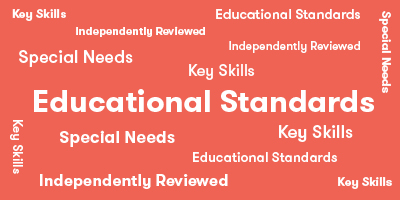
Core Standard*: None

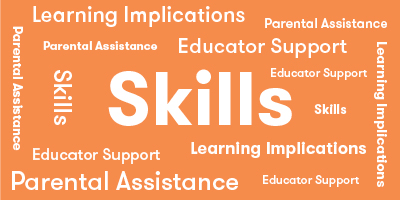
Explore
How Parents Can Assist Learning
Ask follow up questions to encouage a deeper discussion and exploration of why children made their list and why it is was similar or different from other players.
Learning Implications and Educator Support
Ask follow up questions to encouage a deeper discussion and exploration of why children made their list and why it is was similar or different from other players. This is a good way to develop empathy, attention and active listening skills.
Determine
What Does Child Do To Use Skill In The Game?
Players determine if they match words.
How Parents Can Assist Learning
No special parent support required.
Learning Implications and Educator Support
No special educator support required.
>Compare
What Does Child Do To Use Skill In The Game?
Player compare their answers with each other.
How Parents Can Assist Learning
Sometimes there may not be an exact match, such as "candy" and "hard candy". Players should talk before the game starts to agree on what to do in cases of close, but not exact, matches. Also, players need to decide if broad answers like "fruit" are acceptable, or if players need to provide more specific answers like "apple". Players may want to vote with a thumbs up or down on a given answer.
Learning Implications and Educator Support
Eye To Eye involves comparing words and ideas. Educators can expand the learning by discussing what children meant by the words they chose. For example, sometimes there may not be an exact match, such as "candy" and "hard candy". If possilbe, players should talk before the game starts to agree on what to do in cases of close, but not exact, matches. Also, players need to decide if broad answers like "fruit" are acceptable, or if players need to provide more specific answers like "apple". Letting children determine the problem solving approach in cases where there is not an exact match helps them think about fairness and equality.
Remember
What Does Child Do To Use Skill In The Game?
This game is primarily about remembering items, people, places and other information related to specific categories.
How Parents Can Assist Learning
Eye to Eye could be played by children under the age of 12. However, adults may need to remove some cards to which they know children will not be able to provide answers. Or, allow children to have more than one Veto.
Learning Implications and Educator Support
Qrazy Quandries involves a range of memory types, including explicit autobiographical, explicit semantic and explicit episodic memory. Eye to Eye could be played by children under the age of 12. However, adults may need to remove some cards to which they know children will not be able to provide answers. Or, allow children to have more than one Veto.
Predict
How Parents Can Assist Learning
If children are having difficulty making a list, encourage them to focus on their own favorites. As they play more turns, the children will learn more about the other players and then can begin to think about what others might put on a specific top three list.
Learning Implications and Educator Support
If children are having difficulty making a list, encourage them to focus on their own favorites. As they play more turns, the children will learn more about the other players and then can begin to think about what others might put on a specific top three list. Encourage children to think about what the other players have told them or what they have observed them doing. Reflecting on their memories will help them make predictions.
Solve
What Does Child Do To Use Skill In The Game?
Players solve the game by having the most matches, therefore, scoring the fewest points.
How Parents Can Assist Learning
No special parent support required. However, you may need to remove cards that may not be relevant to children.
Learning Implications and Educator Support
No special educator support required. However, you may need to remove cards that may not be relevant to children.
Review
How Parents Can Assist Learning
Eye To Eye can spark lots of great conversations, such as why someone listed an unusual favorite (ex: a candy bar no one else has heard of) or why two players made the same list. These conversations can help build social emotional skills, and strengthen empathy and positive emotions among players.
Learning Implications and Educator Support
Eye To Eye can spark lots of great conversations, such as why someone listed an unusual favorite (ex: a candy bar no one else has heard of) or why two players made the same list. These conversations can help build social emotional skills, and strengthen empathy and positive emotions among players.
*Data compiled from CCSSI ELA Standards, WA Science Standards, and Washington Social Studies Standards

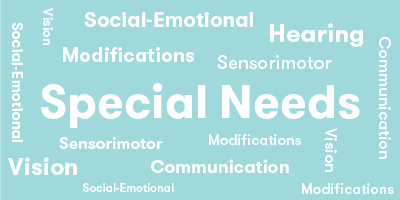
Cognitive
Suggestions for How to Modify Play Experience
Give more veto circles to children with cognitive delays to reject more unfamiliar categories. Another option is to eliminate the cards that are too difficult in the deck ahead of playing the game. This will reduce the frustration for children who may feel uncomfortable competing with people who have more knowledge and experience.
Allow children with cognitive delays to not take a block if they can match two of the three possible words.
Extend the time limit for generating words for children with cognitive delays.
Communication
Suggestions for How to Modify Play Experience
Teams can play Eye to Eye to increase discussion of option. Teams will need to move away from other teams during the discussion phase to make sure others don't hear what they are writing down. For this reason, make the time limit one minute instead of thirty seconds to give people time to move away and then come back together. One team should stay at the game table and call out "Go!" and "Stop" after turning over the timer twice. This collaborative effort enables brainstorming and the selection of the best choices as a team.
Sensorimotor
Suggestions for How to Modify Play Experience
For children with fine motor concerns eliminate the pyramid in the middle and just spread out the blocks to be taken by players. In addition, players may either build a pyramid or choose to just count 15 blocks. The first person to 15 blocks loses.
Social Emotional/Behavioral
Suggestions for How to Modify Play Experience
The game is already a great social game. One way to make it more cooperative is to take a vote on each card selected. Thumbs up for "let's go with this category" and thumbs down for "pick another."
Vision
Suggestions for How to Modify Play Experience
Teams can do Eye to Eye to support children with low vision where at least one person on each team can support child(ren) with low vision. Teams will need to move away from other teams during the discussion phase to make sure others don't hear what they are writing down. For this reason make the time limit one minute instead of thirty seconds to give people time to move away and then come back together. One team should stay at the game table and call out "Go!" and "Stop" after turning over the timer twice. This collaborative effort enables brainstorming and the selection of the best choices as a team.
Hearing
Suggestions for How to Modify Play Experience
The cards are written as are the lists of options. Children with hearing impairments can communicate in written rather than oral format.
*Data compiled from CCSSI ELA Standards, WA Science Standards, and Washington Social Studies Standards

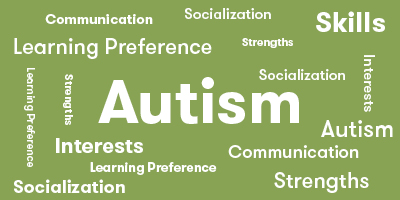
Autism Special Considerations
Appears to ignore other's communication and/or has difficulty giving eye contact to a communication partner
Is This Game Appropriate for Child with Characteristic? Yes
Can Child with Characteristic Play Game w/o Modification? Yes
Strategies for Developing Compensatory Skills:
Although eye contact is not technically required, the game does required players to pay attention to each others comments.
Sit at an angle to the child, so direct eye contact is not needed.
Look at the game instead of each other.
Has difficulty understanding complex verbal directions
Is This Game Appropriate for Child with Characteristic? No
Can Child with Characteristic Play Game w/o Modification?
Strategies for Developing Compensatory Skills:
Break down directions into small steps. Don't go through all the directions at once.
Combine short verbal instructions with visual and physical examples of each step. For example, demonstrate using the measuring tool.
Check for comprehension by asking the child to show you what to do next. For example, what happens when others have what you wrote down?
Let children read the directions as they are explained. Visualizing the words is often a stronger learning method for children with autism.
Uses vocabulary inaccurately or demonstrates echolalia (repeating another's speech)
Is This Game Appropriate for Child with Characteristic? No
Can Child with Characteristic Play Game w/o Modification? No
Strategies for Developing Compensatory Skills:
Children need to be able to accurately read and discuss what they wrote down and discuss others' comments. For this reason Eye to Eye may be difficult for children with special needs who have difficulty producing accurate communication.
Gets stuck repeating a verbal topic or physical actions and/or has difficulty attending to others' actions or topic.
Is This Game Appropriate for Child with Characteristic? No
Can Child with Characteristic Play Game w/o Modification? No
Strategies for Developing Compensatory Skills:
Children need to pay attention to other player's comments and communicate accurately. For some children with special needs this is an issue, and the game may not be appropriate.
Has difficulty producing speech/communication
Is This Game Appropriate for Child with Characteristic? Yes
Can Child with Characteristic Play Game w/o Modification? Yes
Strategies for Developing Compensatory Skills:
Use augmentative communication, such as sign language or just use the written communication on the paper sheets.
Communication during and after a play is required in some form. If children cannot write down their ideas the game is not recommended.
Has difficulty sequencing multi-step actions and/or doing complex abstract tasks
Is This Game Appropriate for Child with Characteristic? No
Can Child with Characteristic Play Game w/o Modification?
Strategies for Developing Compensatory Skills:
Eye to Eye is not appropriate for children who have difficulty comprehending abstract ideas. Children need to be able to think about what other players are thinking in response to a wide range of topics, including some that are more abstract.
Demonstrates difficulty initiating and maintaining social interactions
Is This Game Appropriate for Child with Characteristic? No
Can Child with Characteristic Play Game w/o Modification?
Strategies for Developing Compensatory Skills:
Eye to Eye is a social game requiring understanding of others thoughts and feelings, turn taking, and communication. For this reason, the game is not appropriate for children with these concerns.
Acts out or demonstrates avoidance behaviors when frustrated, overwhelmed, or needs more sensory input.
Is This Game Appropriate for Child with Characteristic? Yes
Can Child with Characteristic Play Game w/o Modification? No
Strategies for Developing Compensatory Skills:
Reduce extraneous noise or allow the child to wear head phones or ear plugs if loud sounds cause anxiety.
A weighted vest worn during the game may provide additional pressure input and thus reduce fidgeting due to sensory needs. Pressure can be calming when used for no more than 20 minutes at a time.
Practice a phrase to ask for help and role play situations in the game where it is needed.
Provide techniques for self-calming, such as holding a special toy.
Allow time for movement. For example, a child who needs to move frequently can be given an opportunity to 'celebrate' their turn by running around the table or jumping up and down 10 times.
Has short attention span for non-preferred activities
Is This Game Appropriate for Child with Characteristic? No
Can Child with Characteristic Play Game w/o Modification? No
Strategies for Developing Compensatory Skills:
Not recommended for children who have a short attention span with regard to conversations.
Needs sameness or consistent routines and/or has difficulty with transitions from one activity to another
Is This Game Appropriate for Child with Characteristic? Yes
Can Child with Characteristic Play Game w/o Modification? Yes
Strategies for Developing Compensatory Skills:
Play games at the same time every day, so the child anticipates the game routine.
Change the location of the game, so the child may play in different rooms, at the table, or on the floor. This will build tolerance for variation.
Prepare the child ahead time for the introduction of a new game. Talk about aspects that will be motivating for the child, and let them explore the parts of the game before setting out the whole game. For example, examine the bones and tiles.
Provide a structure for placement of game pieces that can be the same each time the game is played. For example, have a specific location for where the board goes, the tiles, etc.
Has difficulty understanding others' feelings, intentions, and the reasons for others' actions.
Is This Game Appropriate for Child with Characteristic? No
Can Child with Characteristic Play Game w/o Modification?
Strategies for Developing Compensatory Skills:
Eye to Eye is not recommended for children who have difficulty understanding others intentions and reasoning. Children need to anticipate other players' thinking and respond by writing down comments they think others will also say.
*Data compiled from CCSSI ELA Standards, WA Science Standards, and Washington Social Studies Standards

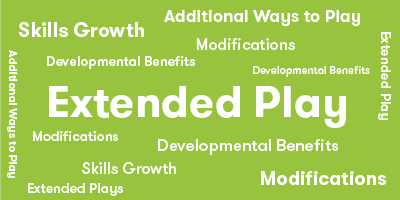
Extra Ways to Play the Game
An interesting variation of the game is to enable players to put a block back in the center of the pyramid in the middle. There are two ways (and potentially more) ways this can happen. One way is to let any player who crosses off all three items on their list put a block back. Another way is to compare rankings of the listed items. When a player is reading his or her list, if any other player has the same item at the same rank, the reader and each person can replace one block. For example, if the reader and another player both write "Amazon" as the first river, they both put a block back in the pile. If more than one item matches at the same rank a block is replaced for each word. If more than one player matches the rank the player reading his or her list, the reader gets only one block for the ranking, not one for each player that matches the rank.
Materials Needed
No additional materials needed.
Developmental Benefits
Allowing players to replace a block occasionally is very reinforcing. Players may actually feel like they can turn back their bad fortune! This is helps build intrinsic motivation.
*Data compiled from CCSSI ELA Standards, WA Science Standards, and Washington Social Studies Standards
Game Details
- 200 Category Cards
- 55 Scoring blocks
- 6 Pencils
- 1 Pad of paper
- 1 30-second timer
- 6 Veto chips
- 1 Rules Booklet








